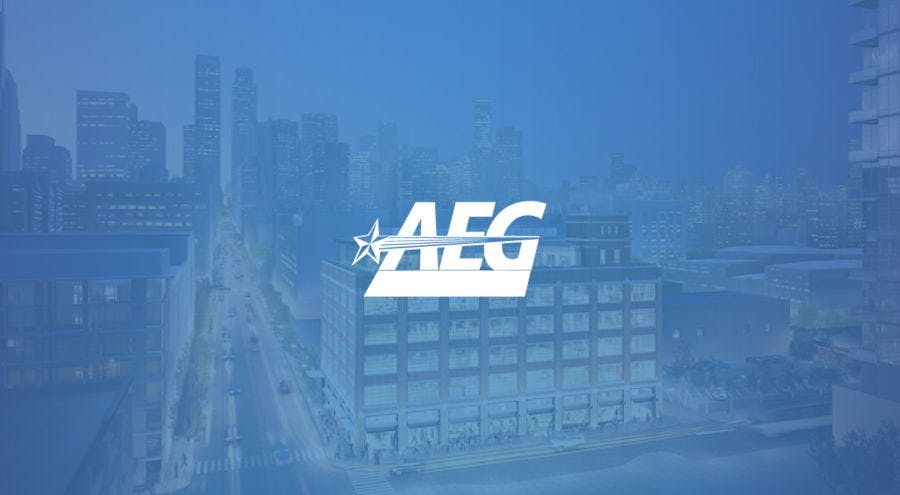Over the last few years, businesses and procurement teams faced a number of unexpected challenges. Through a global crisis and ongoing supply chain disruption, sourcing innovation became critical for lean procurement teams. As circumstances changed rapidly, AEG, a leader in the entertainment industry got creative and turned chaos into an opportunity to evolve. AEG developed a plan to digitize, optimize, centralize and automate their RFPs. They built their new process in our RFP management software, RFP360.
In this customer spotlight blog, we’ll tell AEG’s sourcing innovation story. We’ll share their journey to improve RFP management. To start, we’ll discuss their manual process and what inspired them to look for new solutions. Next, we’ll look into their evaluation process. And finally, we’ll explore the benefits they’ve reported after implementation.

Read the full AEG case study here.
The challenge facing the AEG procurement team
Over the past 20 years, AEG went from owning a single sports team to being the world’s leading sports and live entertainment company. While their portfolio evolved and revenue grew, their RFX process remained the same. Consequently, managing RFXs in Excel spreadsheets and Word documents became a cumbersome, complex and time-consuming process. After this sustained rapid growth, it became clear that their manual process wasn’t sustainable and wouldn’t scale to meet their needs.
In the beginning, like many small businesses, AEG’s sourcing and procurement team was primarily focused on managing direct and indirect spend. However, procurement has now grown into a business services department that handles an array of other activities, including supplier diversity, sustainability, travel and energy services.
The manual RFP process
While the facilities division at AEG used a request for proposal tool to bring visibility and efficiency to the management of more than 120 facilities, they were still struggling with RFX-related inefficiencies. Scott Bosarge, senior vice president of business services at AEG put it this way:
“We were in the manual and paper days. Each facility had their own templates, their own docs and their own terms and conditions. We realized we needed to standardize and streamline the process and create an entire library of different scopes of work. Although there are a lot of commonalities between the services and functions that were performed across the different venues, they were re-creating the wheel every single time.”
An opportunity to optimize
In the fall of 2019, the merger of AEG’s facilities division and the creation of ASM Global prompted the organization to take a deeper look at their current processes and technologies.
Then, in 2020, the COVID-19 pandemic forced dramatic changes to the live entertainment industry. When live events started canceling in 2020, some venues and artists turned to live streaming during the shutdown. Unfortunately, others went out of business completely. It was clear to AEG that they could take advantage of the pause in their everyday business to improve. Over the subsequent months, they assessed what was working, opportunities for improvement and procurement technology solutions to enhance efficiency.
Exploring eRFP solutions
When they looked at their procurement processes, the AEG team identified RFPs as an area of focus. At the time, they were using a project management tool as their sourcing portal. While they had done some customization to make the tool fit their RFP needs, there was room for improvement. Bosarge and team decided to move forward and to digitize their RFX services.
As they explored solutions, it became clear that implementing eRFP software would quickly improve efficiency, enable stakeholder collaboration and yield a significant return on investment with little disruption. AEG started looking for an alternative and they quickly discovered purpose-built RFP software.
When they connected with RFP360, they were “blown away.” The combination of intuitive setup and minimal training meant that any buyer could set up an RFX event efficiently and effectively. In addition, features like RFP weighted scoring, vendor profiles and scoring visibility were game changers.
Often, implementing new software requires a heavy lift from the team. Luckily, RFP360 made it easy to import in existing documents and forms from AEG’s legacy system. Indeed, this made the transition from the old system seamless. When users logged in for the first time, they were welcomed by the documents and RFP templates they were already used to.
Like with any software, asking customer success questions is an important part of the evaluation. This was a key differentiator for Bosarge who said,
“RFP360’s customer service and account management team has been second to none and a complete differentiator since implementation.”
Sourcing innovation benefits
Implementing new technology and optimizing processes after decades is no small feat. However, embracing sourcing innovation and RFP automation quickly delivered value to the AEG team.
RFP scoring
Indeed, one feature quickly emerged as a favorite — RFP scoring. They noticed improvement almost immediately. For example, they now collaborate with key stakeholders to get direct, qualitative feedback inside the software. These stakeholders may include IT, legal, finance, HR and others.
Stakeholder buy in
Each brings expertise to the relevant sections of the RFP, scoring individual responses. The result? Improved engagement, better internal relationships and more buy-in for the procurement process. With both qualitative and quantitative RFP data backing the decisions, decisions are clear and awarding RFPs is easier.
Process improvements
Consistency, standardization and visibility has also improved since implementing RFP360. Account workspaces are used to house specific templates, documents and forms that are unique to the business units. Then, these can be shared and used across other affiliates.
Efficiency
Another big savings is time. These significant time savings resulted in improved RFP quality and vendor experience. According to Borsarge,
“I can’t put an exact dollar number on it, but from the time it took us to create and launch an RFP, at a minimum, it’s reduced our level of effort by 50 percent.”
If the challenges AEG faced sound familiar, an RFP management system with RFP automation might be worth exploring. We asked Bosarge what capabilities he would recommend that other organizations should look for in RFP request management software, and his response was clear, “First and foremost, ease of implementation, and then an increase in productivity.”
You can read the full interview with Bosarge and explore other sourcing innovation case studies here.
